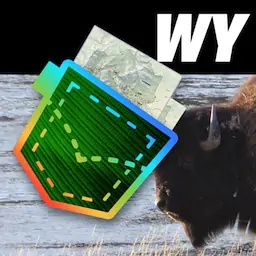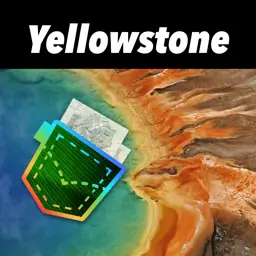"Grand Teton, Moose Entrance" by U.S. National Park Service , public domain
ArcheologyCulture |
11,000 Years of Human Influence: The Archeological Record for Grand Teton National Park (NP) in Wyoming. Published by the National Park Service (NPS).
featured in
| National Parks Pocket Maps |  | |
| Idaho Pocket Maps |  | |
| Wyoming Pocket Maps |  | |
| Yellowstone Pocket Maps |  |
Grand Teton
National Park Service
U.S. Department of the Interior
Grand Teton National Park
John D. Rockefeller, Jr.
Memorial Parkway
11,000 Years of Human Influence:
The Archeological Record
What is Archeology?
Archeology is the study of past human cultures, technologies and behaviors based
on artifacts, landscapes, written records and oral histories. Archeologists consider
projectile points, animal bones, pottery, food remains, clothing and wood to be artifacts.
Archeologists examine both historic and prehistoric (before written history) artifacts
through surface and subsurface explorations, known as survey and excavation, to
research and record the evolution of past human societies.
Archeologists attempt to understand aspects of past human culture and society, such as
diet, housing, migration, and hunting and cooking methods. The goals are to put together
a sequence of events and dates explaining human past; to identify ways of life that no
longer exist; and to create an understanding of how and why human cultures evolve.
Archeology in Grand
Teton National Park
In 1971, Charles Love began archeological research
in Grand Teton National Park. Love discovered,
recorded and analyzed an immense volume of
archeological information from the park, creating
the foundation for future work.
Since then, archeologists working for the
National Park Service and other institutions
have continued to study aspects of prehistoric
lifestyles, establishing archeology as an important
aspect of Grand Teton National Park.
Jackson Hole Prehistory
The first humans entered the Jackson Hole valley
roughly 11,000 years ago, shortly after ice-age
glaciers retreated. Archeologists believe that
Paleoindian hunter-gatherers, 11,000 to 8,000
years ago, spent the late spring and summer in
the valley following wildlife and ripening plants.
They killed large animals such as bison and elk
with projectile point spears including: Agate Basin,
Hell Gap and Cody-type points (Figure 1). Most of
these points were flaked from obsidian, volcanic
glass found in the area.
Artifacts that date from the Archaic period,
8,000 to 1,500 years ago increased in number and
variety. This shift suggests more people entered
the valley and they needed new technologies due
to a changing environment and different wildlife.
Prehistoric people began using roasting pits, large
cooking pits lined with heated stones, around
5,900 years ago.
Figure 1. Timeline of
Grand Teton National
Park prehistory
E X P E R I E N C E Y O U R A M E R I C A™
7/2012
Jackson Hole Prehistory
(continued)
Projectile points made of obsidian evolved to have
side notches, indentations on the sides of a point
used to attach a point to a spear. These points
include McKean and Pelican Lake-type points
(Figure 1). Tipi rings, stone circles used to hold
down the bottom of skin-covered structures, and
stone-grinding tools, rocks used to grind food,
also date to the Archaic period (Figure 2).
Tools continued to evolve from the Archaic to
the Late Prehistoric period 1,500 years ago. Late
Prehistoric populations began using the bow and
arrow as their primary hunting tool (Figure 3).
Using an arrow decreased the size of the projectile
point from the larger spear point. People also
started shaping soapstone bowls and clay pottery
(Figure 4). Archeologists believe hunter-gatherers
in Jackson Hole decreased their seasonal travel
during this period, remaining in the valley for a
longer period of time.
There is no archeological evidence suggesting
prehistoric populations cultivated crops or
established permanent settlements in the valley.
Throughout prehistory people hunted deer,
elk, bighorn sheep, bison and fish; and gathered
cattail, berries, roots and tubers for food. Food
remains combined with other artifacts help
archeologists interpret the prehistory of Jackson
Hole.
Archeological research in Grand Teton National
Park and the Jackson Hole valley continues
to expand our understanding of past human
cultures, technologies and behaviors. Archeology
is an integral part of the National Park Service’s
mission to preserve natural and cultural resources
for the enjoyment, education,
and inspiration of this and future
generations.
The Protohistoric period lasted from 1700 to
1850 in Jackson Hole. During this period, Indians
traded European goods such as beads, axes,
knives, kettles and horses, but kept no records.
After 1850, survey crews began documenting
information about the valley.
Figure 4. Soapstone Bowls
Figure 2. Grinding Stone
Figure 3. Bow and Arrows
How you can help:
Saving the Past for the
Future
• Do not collect archeological artifacts. Collecting
artifacts from federal land is illegal. Artifacts
are fragile, easily disturbed, and nonrenewable.
If properly studied, artifacts may provide new
and important information about the past. If
artifacts are disturbed, vital information may be
lost.
• If you find an artifact, record the location as
accurately as possible, do not disturb the item
and contact a park ranger.
• Do not buy, sell or trade artifacts. Vital research
information will be lost. Artifacts sold on
the commercial market may be looted from
federal lands, destroying research potential and
sometimes desecrating sites and graves.
• Never dig or excavate a site without proper
permission and supervision. Permits are given
to museums, universities, colleges and other
recognized scientific or educational institutions
for research to expand our understanding.
Archeological
Opportunities
• Visit the Craig Thomas Discovery and Visitor
Center in Moose to view natural and cultural
history exhibits of Grand Teton National Park.
• Visit the Colter Bay Visitor Center to view
Native American arts and artifacts.
• Visit the Jackson Hole Historical Society and
Museum in Jackson, Wyoming to view artifacts,
photographs, documents, and media about the
history of Jackson Hole.
• Participate in Wyoming Archaeology Awareness
Month in September and attend Wyoming
archaeology celebrations. For more
information: wyoshpo.state.wy.us/AAmonth/
Index.aspx.
• Volunteer in Grand Teton National Park, or for
archeological projects throughout the country.
For More Information
• For an in depth look at cultural resources in
Grand Teton National Park: www.nps.gov/grte/
historyculture/index.htm
• Read “A Place Called Jackson Hole.” A great
reference containing the prehistory and history
of Jackson Hole: www.cr.nps.gov/history/
online_books/grte2/hrs.htm
• The National Park Service Archeology Program:
www.nps.gov/archeology/
• The Smithsonian Institution’s Department of
Anthropology: anthropology.si.edu/index.html
• Archeological volunteer opportunities with
the US Forest Service Passport in Time
Program: www.passportintime.com/
• More archeological volunteer opportunities:
www.nps.gov/archeology/public/archvol.htm
E X P E R I E N C E Y O U R A M E R I C A™




